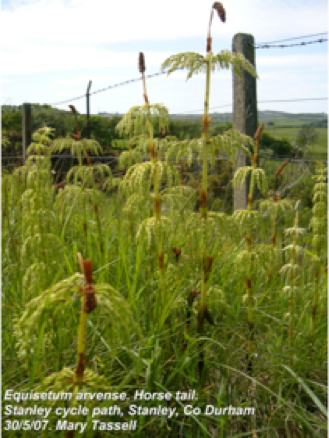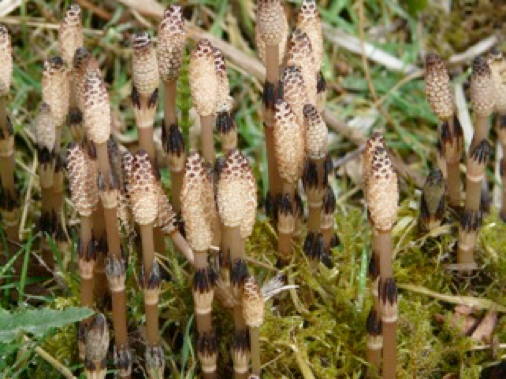A rather squelchy welcome to Februarys edition of Herbs, Healing and Health.
As many of you probably already know, the ancient western world saw everything as composed of four basic elements, earth, air, fire and water (way simpler that todays periodic table). Well, I think we can all safely say that we have seen more than enough of the element of water in the last few months. To counteract all this cold and damp weather, I would definitely advise raising your intake of the warming, drying plants that we have been looking at in the past few editions – your gingers, cinnamons etc. But I know that most of you have probably been doing exactly that, being the intelligent people that you are, so I thought we would have a change of pace for this edition, and I would take a little look at a plant that, again I am sure you are all familiar with, and which has a very specific effect on our own internal waterworks: horsetail (Equisetum arvense).
Dinosaurs and Diuretics
The horsetail family are often referred to (along with the Ginkgo’s) as fossil plants as their lineage dates back over 10 million years. Whilst Mary Annings Plesiosaurs and ichthyosaurs were happily munching on squid and the like, many land based jurrasic creatures depended on horsetails as a significant part of their daily diet. The sceleidosaurus, believed to be almost completely herbiferous, would have dined well on these plants, which provided the understory of late Paleozoic forests (I believe you can see a cast of a sceleidosurus at the Charmouth Heritage Centre). So one thing we immediately know about this plant – it’s a survivor!
back over 10 million years. Whilst Mary Annings Plesiosaurs and ichthyosaurs were happily munching on squid and the like, many land based jurrasic creatures depended on horsetails as a significant part of their daily diet. The sceleidosaurus, believed to be almost completely herbiferous, would have dined well on these plants, which provided the understory of late Paleozoic forests (I believe you can see a cast of a sceleidosurus at the Charmouth Heritage Centre). So one thing we immediately know about this plant – it’s a survivor!
Todays horsetails are moderately innocuous to look at, although I must say I love their appearance when they first emerge in spring. There is definitely something almost fungal about them, and very prehistoric.
Most people, if asked to name a herbal diuretic, would come up with dandelion leaf (the French pis en lit kind of gives the game away), but horsetail is an excellent diuretic, particularly as a tea. Another major benefit comes from the presence of high levels of silica in the plant. Silica accelerates tooth wear, and high levels of silica in plants frequently eaten by herbivores is thought to have developed as a defense mechanism against predation. As we have already seen in the case of the sceleidosaurus, this plant has been grazed on for millions of years, so it has evolved high levels of silica to deal with this problem. This is good news for us humans, as silica is a very valuable compound in the strengthening of tissues such as bones, teeth, hair, nails and ligaments. So, for fractures, hair loss, brittle nails etc, horsetail is your herb. The silica content of this plant is water-soluble, so it is ideal as a tea, the dried herb being most commonly used.
case of the sceleidosaurus, this plant has been grazed on for millions of years, so it has evolved high levels of silica to deal with this problem. This is good news for us humans, as silica is a very valuable compound in the strengthening of tissues such as bones, teeth, hair, nails and ligaments. So, for fractures, hair loss, brittle nails etc, horsetail is your herb. The silica content of this plant is water-soluble, so it is ideal as a tea, the dried herb being most commonly used.
If you are unlucky enough to suffer a sprained ankle or similar soft tissue injury, using really strong horsetail tea in a bath or footbath can work remarkably well.
So, here’s a little useful recipe to deal with weak nails, thin or brittle hair,) or indeed chronic cystitis):
Horsetail syrup
- Around 50g fresh horsetail
- 500ml water
- 100g sugar
- Place all ingredients in a pan together.
Boil, reduce the heat, then simmer for 30 min until the horsetail turns dark green and becomes soft.
Strain and return to the pan with an additional 150g sugar.
Boil for 5 min, cool, bottle.
Makes approx. 400ml syrup.
Take one teaspoon a day for 2 – three weeks, the stop for a week, resuming if needed. [1]
(Recipe taken from Hedgerow Medicine. See Bibliography.)
If you are inspired to go gathering horsetail this year, early summer is the best time to harvest it. Cut the plant a few inches above the ground. Crushing it gently helps release any moisture. Chop and store in an airtight container.
Evidence of this plants long-standing reputation as a wound healer and for pain relief has been underpinned recently by a clinical trial on the use of horsetail ointment in midwifery, post episiotomy. [2] I am sure there are many women out there who have been very grateful for a spot of horsetail ointment. An episiotomy is a deliberately inflicted wound, but of course, this use translates well to wound healing generally. Maria Treben uses horsetail in a wide variety of therapeutic applications, including teas, poultices, foot-baths, vapour baths, sitz baths and compresses. The tea, as a hair wash is used for dandruff, hot compresses utilize the plants anti-inflammatory properties for joint inflammation, and footbaths are used for sweaty feet. [3] That’s to name but a few of the uses and applications of this ancient plant.
On a more practical note, the 16th century name dyshwasshynges’ tells us of horsetails historical use as a pot scourer. [4] Suits of armour and medieval arrow-heads also benefitted from its scouring properties. [5]
So, the Jurrasic coastline and surrounding flooded fields have provided us with the opportunity to focus on an excellent plant with a multiplicity of health benefits, growing right at our feet.
Bibliography
- Bruton-Seal, J. and M. Seal, Hedgerow MedicineHarvest and Make Your Own Herbal Remedies 2009, Shropshire, UK: Merlin Unwin Books Ltd.
- Asgharikhatooni, A., et al., The effect of equisetum arvense (horse tail) ointment on wound healing and pain intensity after episiotomy: a randomized placebo-controlled trial.
. Iran Red Crescent Med J. , 2015. 31(17).
- Treben, M., Health from God’s Garden: Herbal Remedies for Glowing Health and Glorious Well-Being. 1987, Munich: Thorsons.
- Hatfield, G., Memory, Wisdom and Healing. The History of Domestic Plant Medicine. 1999: Sutton Publishing.
- Baker, M., Discovering the Folklore of Plants. 1996, Princes Risborough: Shire Publications.